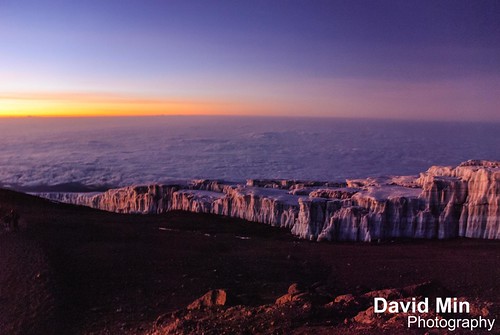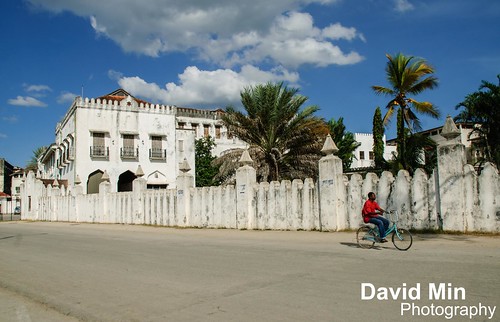The Ngorongoro Conservation Area is a conservation area and a UNESCO World Heritage Site situated 180 km west of Arusha in the Crater Highlands area of Tanzania. The Ngorongoro Crater, a large volcanic caldera, lies within the area.
A population of approximately 25,000 large animals, largely ungulates along with reputedly the highest density of mammalian predators in Africa, lives in the crater. Large animals in the crater include the black rhinoceros, the local population of which declined from about 108 in 1964-66 to between 11-14 in 1995, and the hippopotamus, which is very uncommon in the area. There also are many other ungulates: the wildebeest (7,000 estimated in 1994), the zebra (4,000), the eland, and Grant's and Thompson's gazelles (3,000).
The crater has the densest known population of lions, numbering 62 in 2001. On the crater rim are leopards, elephants – numbering 42 in 1987 but only 29 in 1992 – mountain reedbuck, and buffalo (4,000 in 1994). In the middle of the crater there is a large lake inhabited by hundreds of flamingoes and from a distance, they appear as a pink border of the lake.
Aside from herds of zebra, gazelle, and wildebeest, the crater is home to the "big five" of rhinoceros, lion, leopard, elephant, and buffalo. The crater plays host to almost every individual species of wildlife in East Africa, with an estimated 25 000 animals within the crater.
Monday, October 29, 2012
Ngorongoro Crater, Tanzania
Tuesday, October 9, 2012
Kilimanjaro Summit, Tanzania - Above the clouds 5.50am @Uhuru Peak (5 895m)

Kilimanjaro Summit, Tanzania - Above the clouds 5.50am @Uhuru Peak (5 895m), a photo by GlobeTrotter 2000 on Flickr.
The trek to Uhuru Peak is considered to be a relatively straightforward endeavour; however, ample time must still be provided for proper acclimatization to prevent altitude sickness. The three shortest routes, Marangu, Rongai and Machame are less challenging and are often trekked by individuals with limited mountaineering experience. Taking at least 7 days is the best way to avoid altitude sickness.
Route travel times range from 5 to 9 days to summit and return to the base of the mountain. Huts with cooking facilities, bathrooms, and electricity are available on the Marangu route, and camps with less facilities are available on many other routes. All huts and many camps have rangers stationed at them with rescue facilities (modified wheelbarrows to transport trekkers stricken with altitude sickness to lower altitudes).
Summit attempts are generally undertaken at night so that trekkers can reach the rim of the crater to view the sunrise so typically clients start walking around midnight. walking overnight also means the ground (loose gravel) is frozen, making the going significantly easier.
Friday, October 5, 2012
Stown Town, Zanzibar - Old City
Stone Town is the main city on Zanzibar. It is a city of prominent historical and artistic importance in East Africa. Its architecture, mostly dating back to the 19th century, reflects the diverse influences underlying the Swahili culture, with a unique mixture of Moorish, Arab, Persian, Indian and European elements. For this reason, the town has been included in UNESCO's World Heritage Sites in 2000.
It may not have a particularly romantic name, but Stone Town is the old city and cultural heart of Zanzibar, little changed in the last 200 years. It is a place of winding alleys, bustling bazaars, mosques and grand Arab houses whose original owners vied with each other over the extravagance of their dwellings. This one-upmanship is particularly reflected in the brass-studded, carved, wooden doors - there are more than 500 different examples of this handiwork. You can spend many idle hours and days just wondering through the fascinating labyrinth of narrow streets and alleyways.
Wednesday, October 3, 2012
Kilimanjaro, Tanzania - Karanga High Camp
There are several routes by which to reach Kibo, or Uhuru Peak, the highest summit of Mount Kilimanjaro, namely, Marangu, Rongai, Lemosho, Shira, Umbwe and Machame.
Annually, approximately 15,000 people attempt to reach the summit of the mountain, of whom 40% do so.
Of all the routes, Machame is by far the most scenic albeit steeper route up the mountain. The Rongai is the easiest camping route and the Marangu is also easy, but accommodation is in huts. As a result, this route tends to be very busy and ascent and descent routes are the same. Although the Rongai route is a flatter walk it offers less opportunities for acclimatisation. The Machame and Lemosho routes both allow better opportunities to "walk high and sleep low" which is critical to avoiding altitude sickness.
The fourth day of trekking starts with the ascent of the Barranco Wall, which is considered a scramble in climbing terms. The top of the Wall has attractive vistas of Kibo and the surrounding landscape. The trail continues with many up and down sections across small streams and rivulets, and finally crosses the Karanga River to the Karanga campsite.


